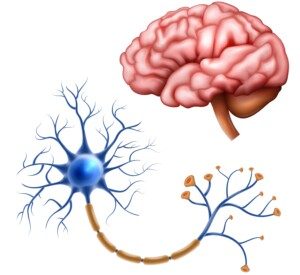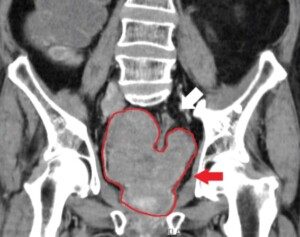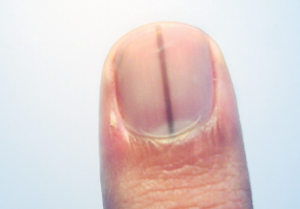Don’t let the funky name, “rapid prompting method,” fool you: This is facilitated communication in disguise with just some minor procedural differences.
Facilitated communication (FC) emerged in the early 1990s, promising a breakthrough for autistic people who were completely nonverbal.
The technique involves a facilitator physically supporting, or what seems like outright moving, the hand or arm of the autistic individual as they point to letters on a board.
The pointer finger typically appears limp, not deliberate. In fact, if you view FC in action, you’ll note that the entire hand appears floppy while it’s being held (or “guided”) at the wrist by the facilitator.
Proponents of this disproven method will argue that the speller lacks muscle control or has poor muscle tone.
This then begs the question: Why do nonverbal autistic people, who are set up with FC, just also happen to have poor muscle control?
Extensive research has debunked FC’s claims. Numerous controlled studies have demonstrated that when facilitators don’t know the question that’s given to the Autistic, the communication produced is often inaccurate or nonsensical.
For instance, a study published in the Journal of Autism and Developmental Disorders (Mostert, 2001) found that when facilitators did not know the answers to questions, the responses were incorrect.
This suggests (quite strongly, actually) that the facilitator, not the Autist, was guiding the communication.
This guidance is believed to be mostly subconscious, rather than deliberate in the name of wanting to participate in a scam.
This subconscious help is akin to the subconscious guidance of a Ouija board planchette: the heart shaped device that “moves” across the board to spell out messages.
This psychological phenomenon is called the ideomotor effect.
It’s when a thought or idea causes an involuntary and subconscious motor movement.
It’s also seen in pendulum divination. A classic example is that of dangling a weighted object on a string before a pregnant woman’s belly to observe the swing pattern to determine the baby’s gender.
Anticipating the sensory consequences of an action can trigger the action itself, even without conscious intent, leading the person to attribute the movement to an external force rather than their own subconscious actions.
So for FC, remember that phenomenon: ideomotor effect.
Resurrecting FC Under a New Name
In response to the controversies surrounding FC, the rapid prompting method was introduced.
RPM involves a facilitator providing rapid verbal prompts while the individual points to letters on a board to spell out their thoughts or answers to questions.
RPM uses a lightweight letter board that’s held before the individual by the facilitator.
A common form of this board is stencil, enabling the Autist to show selection of letters by poking a pen, pencil or similar object through an opening within the letter.
If you watch a video of this, the board is never held still. It moves. Critics point out that this movement is subconscious: The facilitator is doing the spelling. Remember ideomotor effect?
Even tiny, unconscious movements by the facilitator — tilting the board slightly, nudging it — can guide the individual’s finger to the correct letters
A systematic review published in Review Journal of Autism and Developmental Disorders (Schlosser, 2019) found no scientific evidence to support RPM’s effectiveness.
Additionally, the American Speech-Language-Hearing Association has cautioned against the use of RPM, labeling it a discredited technique, involving facilitator bias, that lacks scientific validation (ASHA, 2019).
RPM is actually a form of typing; think about this. How is it that someone could suddenly spell by poking a pen into a letter board — but was never typing by poking a finger, or pen for that matter, onto a keyboard?
Nonspeaking (complete absence of speech, though “nonverbal” is commonly used to refer to such) autistic individuals have significant impairment in motor planning and coordination, making it unlikely that they could independently produce complex communication through letter boards.
The key word here is “complex.” There are nonspeaking Autistics who can spell out simple single words when prompted, without physical guidance, such as pointing to C-A-K-E when asked, “Do you want cake?”
But have you noticed that in stories of autistic adults who have “found their voice” through the “miracle” of RPM (or FC), that their communication is, indeed, complex?
We’re not talking poking out:
W-A-N-T G-O H-O-M-E
These are adults or teens who’ve never had traditional schooling, who’ve never been seen reading books, who’ve never taken it upon themselves to grab a pencil and scrawl letters on paper, who’ve never approached a parent while they were using a computer and began single-finger-typing their thoughts on the keyboard — yet who now can suddenly compose, via letter pointing, complex narratives that most college students can’t even produce as far as eloquence, syntax, metaphors and other components of the advanced written word.
Some of these compositions read as though they’ve been written by professional writers or people with high levels of education.
In “nonverbal” autism (completely nonspeaking – not even able to utter “yes,” “Dad” or “Ma”), motor planning networks involved in speech and writing are underdeveloped or impaired.
The Neurology Behind Spelling By Pointing to Letters

Freepik
Motor planning. Spelling via pointing at a letter board requires precise finger movements and sequencing — the same kind of planning that’s involved in typing (including using a standard keyboard with only an index finger) or writing or printing on paper.
Visual-spatial coordination. The person has to accurately map what they intend to spell onto the physical letter board – and this visual-spatial coordination is the same as required for typing, writing or printing – even sloppily with a crayon.
Working memory and sequencing. Spelling words (regardless of medium, be it pointing a pen at a stencil alphabet or printing letters with a thick marker) in proper order requires holding letters in mind while coordinating movement.
If a nonspeaking Autist has never been able to put pencil to paper and write out their thoughts, or even clumsily poke an index finger to a standard keyboard to spell either into a blank document or for someone to read the letters as they’re being tapped – then there is no way that they will suddenly be fluently spelling via pointing to a letter board.
This simply is not consistent with what science knows about motor learning along with neurodevelopment.
You should be very leery of claims by a parent that their nonverbal or nonspeaking young adult child with autism – who has never expressed any form of standard communication (writing, typing, American Sign Language or even cutting out words from a magazine and gluing them on paper to form simple sentences) – has overnight begun composing complete sentences through RPM.
The sudden ability to produce complex, coherent sentences through the rapid prompting method is extremely unlikely to be originating independently from the autistic individual’s brain – especially if the message expresses advanced thinking such as a desire to attend college or have a career in engineering or medicine.
This is not an accusation of intentional fraud — it’s the well-documented ideomotor effect.
Typing, writing/printing and American Sign Language all require manual motor planning, neuro-sequencing and sensory feedback. Speech requires vocal motor planning, and of course, neuro-sequencing and sensory feedback.
A nonverbal autistic individual who cannot type, sign (ASL) or lip-synch / mouth out words has motor planning impairments that affect all these modalities.
RPM does not remove these motor planning requirements; it instead introduces facilitator guidance, which can mask the fact that the nonverbal individual is not independently performing the task.
Proponents of RPM and its sibling, FC, often cite that the individual lacks hand and finger coordination, requiring a facilitator to hold their wrist or hover the letter board before them.
But even someone with poor motor control should be able to land a pen or stylus on the correct letter if the board is on a table – not held by an eager facilitator.
Clumsy hands can also construct words out of magnetic letters you place on a special board. Autism isn’t cerebral palsy.

Freepik/fabrikasimf
And as previously mentioned, why is it that the absence of speech always seems to come with this alleged poor hand coordination?
I know a man with Level 3 autism (very substantial support needs) who uses a letter board held by a facilitator, while the provider’s other hand is holding this man’s floppy hand by the wrist.
As the man “spells,” his eyes are anywhere but on the board; like way off to the side.
I’ve seen him at various autism functions (I’m autistic) and have witnessed this fiasco, carried out by a paid aide, numerous times.
The first day I met the man I asked the provider if I could facilitate. I acted as though I believed in the method.
I very lightly held the man’s wrist and asked an easy question. Needless to say, the hand went nowhere. I tried another question: ditto.
The provider said, “I think he’s over-stimulated. Maybe some other time.”
Some Nonspeaking Autistic People CAN Spell
Just because FC and RPM indicate facilitator bias and have not been supported by scientific investigations as valid, doesn’t mean that nonspeaking Autists who can spell don’t exist.
I know one. I’ve worked with “Payzley” as a community connector. She can’t even utter “yeah,” “no” or other rudimentary words.
But I’ve witnessed her printing “yes” on paper with a pen in answer to a question.
One day I asked what she wanted to do and handed her a pad and pen.
Payzley wrote u-n-c-k. I asked her to try again. She wrote u-n-c-h. I asked if she wanted to eat lunch. She nodded.
Nevertheless, she’s unable to print simple phrases, and (at least in my experience), usually scribbles when asked to write an answer.
She doesn’t use an iPad designed for communication, nor can she spell using a letter board.
I don’t know Payzley’s educational history, but perhaps these communication modes were never introduced to her during the developmental time window that was optimal to learn these modes with intense training.
Destroying the Parents’ Fantasy that Their “Silent” Autistic Child Now Has a Voice
- Persisting with RPM risks wasting years on a method that doesn’t develop true communication skills.
- It delays access to effective alternatives like AAC.
- False hope can lead parents to ignore real interventions, create unrealistic expectations and even expose the child to situations where facilitator influence is mistaken for their own intent, causing long-term emotional and practical harm.










































